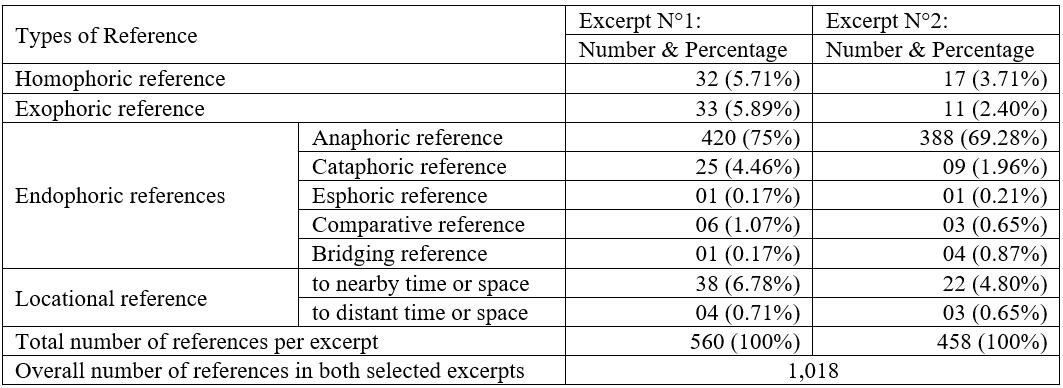Discourse-semantics Analysis of References in two Selected Excerpts from Chimamanda Ngozi Adichie’s Americanah
Abstract
This article seeks to explore the discourse-semantics of two selected excerpts from Chimamanda Ngozi Adichie’s Americanah with a focus on reference chains study. The choice to focus on studying reference chains in the selected excerpts aims at first appraising the way Adichie has used them to realize texture within her studied texts. It second aims at finding the extent to which references have contributed to the encoding of underlying meanings therein. To arrive at this, the research has appealed to the mixed quantitative and qualitative methodology. Through the quantitative methodology, the data obtained after analyses have been summarized organized and presented statistically in an informative way. The qualitative methodology ensued has allowed to give sense to the most interpretable data collected. Indeed, the research has interestingly arrived at impressive results. Among several others, the research has revealed that the studied texts are highly cohesive with endophoric references largely predominating over the other reference types. Using such cohesive ties as Adichie has done, has allowed her texts not only to stick together but also to be highly readable and flow logically. Moreover, the extensive use of endophoric references, as witnessed in the studied texts, is revelatory of their mode which is archetypal of a monologic written text. In other respects, the considerable number of exophoric references in the first excerpt reveals its tenor dimension. Such a linguistic feature indicates that it was produced in a context of immediate face-to-face feedbacks with language accompanying action. On the other hand, the fewer number of the same reference type in the second excerpt reveals its field and unveils that it is a written reflective text reconstructing an experience. Drawing upon the theoretically founded analysis of the selected excerpts and the interpretation of the collected data arrived at, the research opens up to such further investigation areas of the systemic functional linguistics as the interpersonal meaning, the experiential meaning, and the textual meaning.
Downloads
References
Eggins, S. (1994). An Introduction to Systemic Functional Linguistics. London, UnitedKingdom: Printer publishers Ltd.
Gee, J. P. (2006). An introduction to Discourse analysis: Theory and method, 2nd editionNew York: Routledge
Gillian, B., & Yule, G. (1989). Discourse Analysis. Cambridge: Cambridge University Press.
Halliday, M. A. K. (1978). Language as social semiotic. London: Edward Arnold.
Halliday, M. A. K. (1985 a). Introduction to Functional Grammar. London: Edward Arnold.
Halliday, M. A. K. (1985b). Spoken and Written Language. Greelong, Vic: Deakin UniversityPress.
Halliday, M. A. K. (1994). Introduction to Functional Grammar London, New York, etc: Arnold.
Halliday, M. A. K., & Hasan, R. (1976). Cohesion in English. London: Longman.
Halliday, M. A. K., & Martin, J. R. (1993). Writing Science. Literary and Discursive Power. London: The Falmer Press.
Halliday, M. A. K., & Hasan, R. (1985). Language, Text and Context. Vic: DeakinUniversity Press.
Hoey, M. (2001). Textual Interaction: An Introduction to Written Discourse Analysis; Oxford: Routledge.
Martin, J. R. (1992a). English Text: system and structure. Amsterdam: Benjamins.Nunan, David. (1993) Introducing Discourse Analysis. New York: Penguin English.
Titscher, Stefan, et al. (2000) Method of Text and Discourse Analysis. London: SAGE Publications.
Yule, G. (2010). The Study of Language (4th ed.). USA: Cambridge University Press.


This work is licensed under a Creative Commons Attribution 4.0 International License.
Copyright for this article is retained by the author(s), with first publication rights granted to the journal.
This is an open-access article distributed under the terms and conditions of the Creative Commons Attribution license (http://creativecommons.org/licenses/by/4.0/).









1.png)









1.png)











